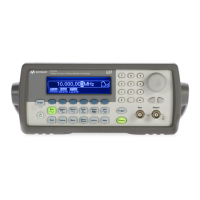84
Chapter 3 Features and Functions
Pulse Width Modulation (PWM)
3
Pulse Width Modulation (PWM)
In Pulse Width Modulation (PWM), the width of a pulse waveform is
varied by the instantaneous voltage of the modulating waveform. The
width of the pulse can be expressed either as a pulse width (expressed in
time units, like the period) or a duty cycle (expressed as a percentage of
the period). The function generator will accept an internal or external
modulation source.
For more information on the fundamentals of Pulse Width Modulation,
refer to chapter 7, “Tutorial”.
To Select PWM Modulation
• The function generator only allows PWM to be selected for a pulse
waveform, and PWM is the only modulation type supported for pulse.
• The function generator will not allow PWM to be enabled at the same
time that sweep or burst is enabled.
• Front-Panel Operation: You must enable PWM before setting up any
of the other modulation parameters. Press to select pulse, and
then press to turn on modulation. PWM is selected as the only
modulation type supported for pulse. The PWM waveform is output
using the present settings for the pulse frequency, modulating
frequency, output amplitude, offset voltage, pulse width, and edge
time.
• Remote Interface Operation: To avoid multiple waveform changes,
enable PWM after you have set up the other modulation parameters.
PWM:STATe {OFF|ON}
33210A users guide.book Page 84 Wednesday, July 16, 2008 11:16 AM

